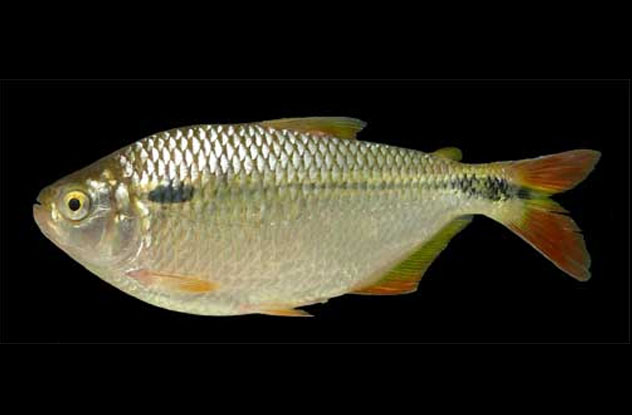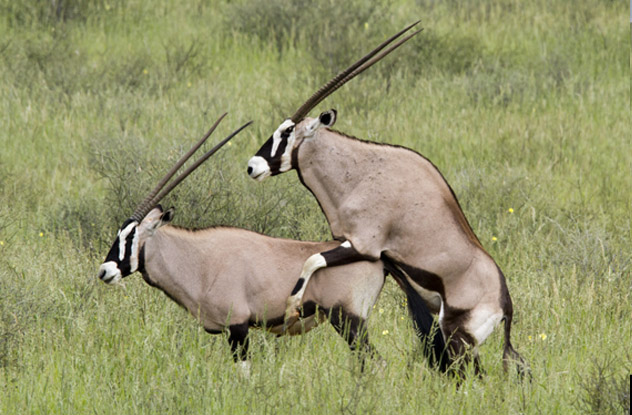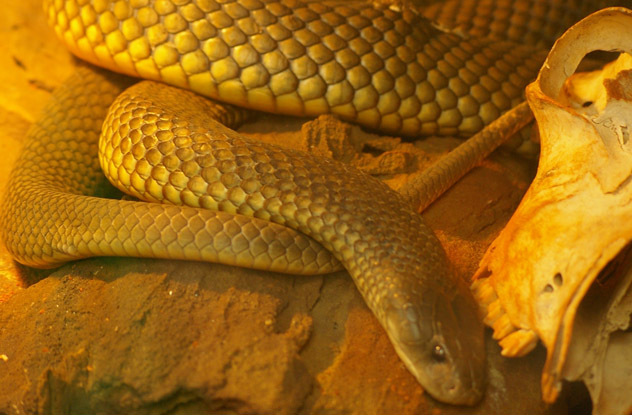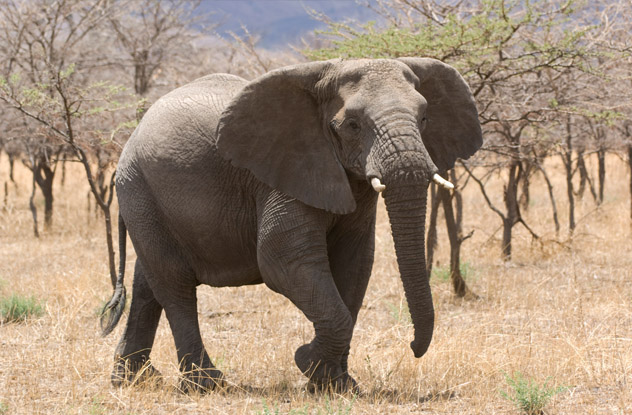 Technology
Technology  Technology
Technology  Humans
Humans 10 Everyday Human Behaviors That Are Actually Survival Instincts
 Animals
Animals 10 Animals That Humiliated and Harmed Historical Leaders
 History
History 10 Most Influential Protests in Modern History
 Creepy
Creepy 10 More Representations of Death from Myth, Legend, and Folktale
 Technology
Technology 10 Scientific Breakthroughs of 2025 That’ll Change Everything
 Our World
Our World 10 Ways Icelandic Culture Makes Other Countries Look Boring
 Misconceptions
Misconceptions 10 Common Misconceptions About the Victorian Era
 Mysteries
Mysteries 10 Strange Unexplained Mysteries of 2025
 Miscellaneous
Miscellaneous 10 of History’s Most Bell-Ringing Finishing Moves
 Technology
Technology Top 10 Everyday Tech Buzzwords That Hide a Darker Past
 Humans
Humans 10 Everyday Human Behaviors That Are Actually Survival Instincts
 Animals
Animals 10 Animals That Humiliated and Harmed Historical Leaders
Who's Behind Listverse?

Jamie Frater
Head Editor
Jamie founded Listverse due to an insatiable desire to share fascinating, obscure, and bizarre facts. He has been a guest speaker on numerous national radio and television stations and is a five time published author.
More About Us History
History 10 Most Influential Protests in Modern History
 Creepy
Creepy 10 More Representations of Death from Myth, Legend, and Folktale
 Technology
Technology 10 Scientific Breakthroughs of 2025 That’ll Change Everything
 Our World
Our World 10 Ways Icelandic Culture Makes Other Countries Look Boring
 Misconceptions
Misconceptions 10 Common Misconceptions About the Victorian Era
 Mysteries
Mysteries 10 Strange Unexplained Mysteries of 2025
 Miscellaneous
Miscellaneous 10 of History’s Most Bell-Ringing Finishing Moves
10 Horrifying Facts To Change What You Think Of Animals
Learning about animals isn’t always fun. Occasionally, you hear something so upsetting that you swear you’ll never go outside again. Or at the very least, you’ll never look at your favorite critter the same way. Animals don’t play by human rules, and from time to time, they’re sure to break our hearts, turn our stomachs, and eat our innards.
10Lassie Won’t Save You

We’ve all heard stories about dogs rescuing their owners from imminent death, but according to researchers at the University of Western Ontario, those pets are the exception to the rule. Most mutts aren’t smart enough to lend a helping paw. Even worse, some just don’t care.
In the first of two tests, 12 dog owners took their pets for walks through an open field. With the exception of one stranger and a hidden camera, the field was empty. Once man and beast reached a prearranged spot, the owner faked a heart attack and collapsed to the ground.
What happened next would make Rin Tin Tin slink away in shame. The dogs poked and prodded their owners for a few minutes, and when the humans didn’t respond, the canines spent the rest of the time just milling around the field. Only one of the dogs, a toy poodle, ever went up to the stranger, and it just wanted to be petted.
Wondering if maybe the presence of a stranger confused the dogs, or if they didn’t understand the concept of a heart attack, the researchers devised a second test. This time, owners walked into an office, past someone in the front lobby, and into a back room, where they became trapped under a fallen bookcase. They begged and pleaded for their dogs to run to the lobby and bring help.
Sadly, just like the first test, the dogs didn’t respond. Perhaps if they’d been trained as rescue dogs they would’ve known what to do, but without any experience, these canines just stood there looking stupid. So much for man’s best friend.
9Shoaling Fish Are Backstabbing Traitors

Two campers are tromping through the woods when they come across an angry bear. The first camper says, “I’m glad I wore my running shoes.” The second shouts, “You can’t outrun a bear!” “I don’t have to outrun the bear,” number one replies. “I just have to outrun you!”
The old joke describes a real survival strategy—passive or indirect selfish behavior, which is surprisingly common in the animal kingdom. Scientists have seen plenty of creatures trying to hide behind their friends when predators show up. However, researchers from the University of Salford Manchester recently found some animals a little more diabolical when it comes to self-preservation.
In a study conducted on 64 two-spot astyanax, biologists discovered some fish intentionally injure their buddies when confronted with a hungry predator. Using a fake tiger fish attached to a string, researchers chased the astyanax around an aquarium and watched as a few of them went into full Judas mode. Sometimes, one fish would bite another, and on several occasions, two astyanax would gang up on one.
They were doing more than handicapping one fish so the predators would easily catch it. When fish are hurt, they release alarm cues that warn the rest of the school of danger—and that attract predators. Knowing full well the tiger fish would smell their wounded friend, these astyanax fish intentionally hurt their schoolmate, hoping to draw the predator away from themselves.
8Male Antelopes Psychologically Manipulate Females

In 2010, Jacob Bro-Jorgensen from the University of Liverpool reported that after mating, female topi antelopes often wander off. But if the male wants a little more action, he has as a devious way of tricking his girlfriend into staying.
The male runs out in front of the female and stares off into the brush. Suddenly, his ears prick up, and he starts snorting, signs that indicate danger. He’s tricking the female into thinking there’s a lion or wild dog on the prowl, and wouldn’t it be safer if she stayed with him a little while longer?
In the male’s defense, females are only in heat for one day during the entire year, a day she spends traveling from spot to spot, mating with about four different males, around 11 times each. The competition is pretty tough for males wanting to successfully sow their seed, and that’s why they fool females into sticking around. It gives them the opportunity to mate a few extra times, giving them an advantage over the other guys on the savanna.
Topi behavior also goes far past psychological manipulation. These animals are murderous. On occasion, they’ve been known to keep quiet if they see a predator sneaking up on a romantic rival. All is fair in love and war.
7Koalas Can Give You STDs
While they might look cute and cuddly, you don’t want to get too close to a koala. You especially don’t want to pick one up—most of them are infected with Chlamydia. As we’ve read before, up to 90 percent of the little guys are infected with the silent STD, and they’re only too happy to pass it around. They’ll even share it with humans.
Koalas can carry one of two strains of Chlamydia, C. pecorum and C. pneumonia. While C. pecorum only shows up in creatures like koalas, water buffaloes, pigs, and bandicoots, it turns out humans are quite susceptible to C. pneumonia, a nasty bacterium that leads to respiratory infections.
That’s right. A koala can give you an STD, though not in the way you’re thinking. Koalas share their STD with humans through their urine. If you pick up one of these plague-ridden marsupials, the koala might decide to relieve itself all over the place. Its bacteria-laced urine then splashes on you. That leads to quite a few unpleasant symptoms and a rather embarrassing conversation with your significant other.
6Caterpillars Eat Flesh
Remember those nasty giant bugs that attack the heroes in King Kong? Well, shrink those down a bit, and you’ve got the flesh-eating butterfly larva of the Hawaiian Islands. Instead of munching on leaves like your average caterpillar, these monsters prefer dining on flies, roaches, or other caterpillars. They wouldn’t eat a plant if they were starving.
Equipped with hook-like appendages, these members of the genus Eupithecia spend their days attached to twigs and leaves, waiting for some unsuspecting insect to walk by. When a fly brushes against the larva’s body, the caterpillar attacks like a spring-loaded trap, sinking its sharp forelegs into the insect’s body.
The Eupithecia caterpillars aren’t the only meat-eating larvae on the islands. Meet Hyposmocoma molluscivora, a caterpillar that drags its home wherever it goes. These animals live in silk casings and pull them along tree branches in their hunt for snails. Whenever H. molluscivora comes across a hapless gastropod, it goes into spider mode and wraps the snail up with its silk. That way, the snail can’t shut itself inside its shell or drop off the branch. The caterpillar then jams its mobile home inside the shell, trapping its prey.
After the larva is done slurping down its dinner, it often attaches the shell to its own home, providing camouflage for future attacks.
5Meerkats Are Murderous Slave Owners

It’s well known that meerkats hang out with warthogs, live in jungle paradises, and sing “Hakuna Matata” every chance they get. They’re also violent monsters that practice infanticide and force subordinates to do their bidding.
A meerkat mob is ruled by an alpha couple, a male and female that demand total obedience and punish offenders with exile. These little dictators assign duties and strictly regulate who can mate with whom. For the most part, only the alpha couple can procreate, and when a lower-level meerkat breaks sexual protocol, things take a very dark turn.
If a female gives birth to a litter of pups, the dominant female will murder every last one of them. The offending mother then gets two options. She can either raise the alpha female’s babies, or she can leave the colony forever. Usually, meerkats choose Option A, becoming wet nurse slaves. The few that don’t are banished from the mob, forced to survive on their own.
As you might assume, life is pretty challenging for a lone meerkat, and most females kicked out of the clan are quickly killed by predators. Terrified, a few actually return to the colony and beg to be let back in. If they’re accepted, they’re enslaved and forced to care for the queen’s kids, a job that consumes all their time and causes them to lose an incredible amount of weight.
4Mulga Snakes Will Bite You In Your Sleep

Snakes are more scared of us than we are of them. They only bite if they feel threatened, and more often than not, they’ll run away from people . . . except for the mulga snake. This slithering nightmare bites people in their sleep.
The mulga (also known as the king brown) is the largest venomous land snake in Australia, and that’s really saying something considering the Land Down Under’s wide array of deadly serpents. While the mulga isn’t as deadly as, say, a taipan, it delivers way more venom than most of its Aussie cousins. Whereas a tiger snake only produces 10–20 milligrams when milked, the mulga yields closer to 150 milligrams.
In a recent study, scientists analyzed 27 cases of king brown bites. While most involved humans acting like idiots and trying to pick up the snakes, 10 occurred without any prompting on the human’s part. Seven occurred while the victims were in their beds, snoozing away.
The researchers weren’t exactly sure why the snakes targeted sleeping humans. Perhaps they’d originally been attracted by rodents and were startled when they came across a person. Or, much more disturbingly, perhaps they’d been drawn in by the sleeper’s body heat. Or perhaps they’ve lost their taste for mice and want something a tad meatier. Sleep tight, all you Australians.
3Hippos Are Carnivore Cannibals
Quite a few alleged herbivores are secretly partial to a nice chunk of flesh from time to time. However, most of those creatures would probably never eat their own kind. Hippos, on the other hand, are the giant Hannibal Lecters of the mammal family. Hippo cannibalism has been documented on several occasions and has even been captured on film.
Obviously, it’s abnormal behavior for the usually vegetarian creatures, but if they’re stressed out due to overcrowding or suffering from nutritional deficiencies, they won’t hesitate to chow down on a deceased relative. Hippo cannibalism isn’t healthy, and some scientists believe it contributed to a massive anthrax outbreak in 2004 that killed hundreds.
Hippos also eat creatures other than just their kin. They’ve been known to munch on the corpses of impalas from time to time, and one wild report from the government of Addis Ababa claimed that some hippos were actually hunting down cattle. Hippos have long been known to attack people, killing up to 2,900 annually, and they may eat humans as well..
River guide Paul Templer was working his way down the Zimbabwe’s Zambezi River in 2013 when he was rushed by a bull hippo. The irate beast killed Paul’s apprentice and then turned its attention on Paul himself. As the man later put it, “There was no transition at all . . . It was as if I had suddenly gone deaf and blind.” Just a few moments before, he’d been surrounded by sunshine. Now he was engulfed by darkness, slime, and a horrible smell “like rotten eggs.” He could feel water on his legs, but his top half was relatively dry . . . and that’s when he realized he was inside the hippopotamus.
He’d been swallowed—but he managed to drag himself out. The hippo then grabbed him again and sank under the water, taking Templer along for the ride, before finally releasing him. All in all, Templer suffered 40 deep wounds, some of which exposed his lungs, and one of his arms was amputated. But had the hippo actually tried to eat him? Or was it simply trying to kill him?
Either way, it’s enough evidence that anyone valuing their lives should stay away from the Zambezi River . . . unless you’re Paul Templer. After he recuperated, he went right back to his old job, taking tourists down the river. Templer may be missing an arm, but he has no shortage of guts.
2Sea Turtles Will Rape You

During mating season, male sea turtles are constantly looking for their next conquest. These shelled reptiles, which can weigh up to 180 kilograms (400 lb), approach females from behind, grab the shoulders with their clawed flippers, and then latch on with a claw-like tip on their tail. Next, they generally pin their mate to the ocean floor and hang on for hours, sometimes 12 or more.
That’s all well and good when it’s turtle-on-turtle action, but things get a lot more dangerous (and humiliating) when the reptiles decide they want to hit on humans. In 2007, conservation geneticist Brian Bowen was collecting fish off the coast of Australia when a randy, 100-kilogram (220 lb) green turtle tried to mount him. Bowen was able to keep the creature at bay with his Hawaiian sling, fighting off three more attempts before the heartbroken beast swam away.
Bruce Gernon, an Islamorda real estate agent, was similarly assaulted by a loggerhead turtle that drove him to the ocean bottom. As the turtle wrapped its flippers around his shoulders and, as Bruce put it, “probed me in the backside,” the man managed to shove a lobster into the turtle’s face. The confused reptile let Gernon go, giving the diver enough time to swim to safety.
1Elephants Might Eat You

In the 2011, in Sundarban Islands of West Bengal, India, a community was under siege. As farmers cleared land for crops, they started running into more and more elephants. Quite often, these close encounters turned into bloody massacres where the humans were squished like bugs.
As many of the farmers were Hindu, they believed it wrong to kill the elephants. However, they were willing to make an exception for one particularly murderous female. This single elephant had claimed 17 lives, and wildlife officials received permission to hunt it down. After a successful shot, the authorities performed a necropsy, and to their horror, they discovered this elephant had swallowed one of her victims. It’s believed the animal snapped after she witnessed farmers chasing her calf.
While the disturbing behavior is extremely rare, this wasn’t an isolated incident. In the past, scientists have witnessed elephants dig up and devour human remains. And then there’s the troubling tale of Chang, the Asian elephant who lived in the Zurich Zoo. Chang had quite the violent temperament, but despite his bad behavior, he became the favorite of Bertha Walt, a regular visitor who felt a special connection with the creature. Bertha believed all “animals were kinder than people,” and when she discovered the keeper’s entrance to Chang’s cage, she decided to go inside and make friends.
One night when the zoo was empty, Bertha slipped inside Chang’s pen . . . and was gobbled up. Not only did Chang eat her body, he ate her clothes, her shoes, and for good measure, he downed her purse as well. However, the zoo didn’t put Chang down. His life was saved thanks to the protests of his keeper, Hans Reitmann.
Chang wasn’t all that appreciative. Shortly after snacking on Bertha, he murdered Reitmann as well.
+Crocodiles Can Climb Trees
Once you step into a crocodile’s territory, there’s nowhere you can run, nowhere you can hide. If it wants to eat you, it’s probably going to get you. In the water, crocs can swim up to 32 kilometers (20 mi) per hour, and on land, they can gallop up to 17 kilometers (11 miles) per hour for short distances. Sure, if you dodged that initial lunge, you might outrun the beast, but don’t ever make the mistake of climbing up a tree. Crocodiles and alligators are quite adept at working their way up tree trunks.
Scientists have recorded incidents of crocodilians climbing their way up into places they don’t belong since 1972, and the anecdotal evidence stretches back even further. Reptiles in Mexico, Mississippi, Colombia, Australia, and the Nile have all been found lounging in tree branches, sometimes up to 5 meters (16 ft) away from the riverbank. Baby crocs have been found hanging from reeds while older ones have been spotted 10 meters (32 ft) in the air.
Scientists assume the crocs are probably sunning themselves or, even worse, trying to get a better view of their surroundings. But what’s truly terrifying is that one group of scientists in Australia witnessed a croc trying to scale a chain-link fence. There is no escaping. The crocodile will get you.
Nolan Moore is never going outside again. If you want, you can follow/friend him on Facebook or send him an email.








